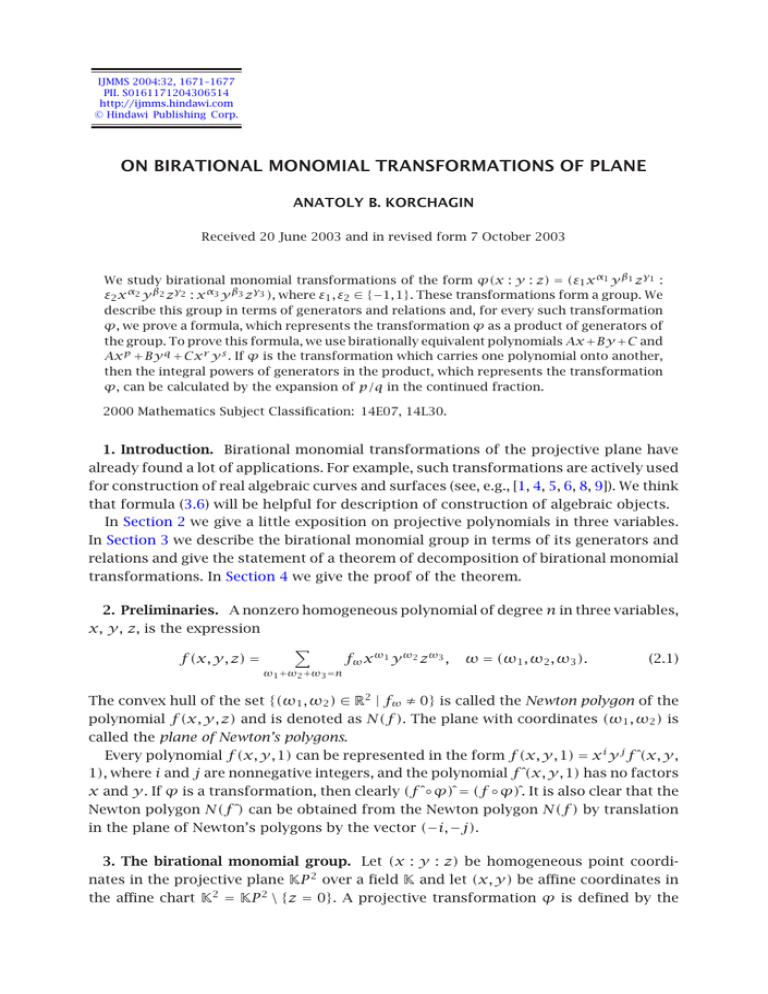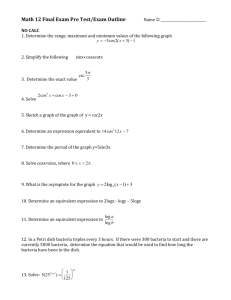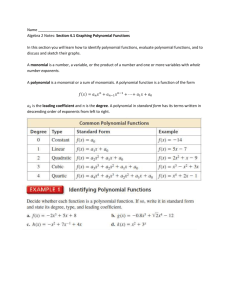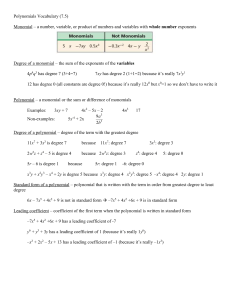ON BIRATIONAL MONOMIAL TRANSFORMATIONS OF PLANE ANATOLY B. KORCHAGIN
advertisement

IJMMS 2004:32, 1671–1677
PII. S0161171204306514
http://ijmms.hindawi.com
© Hindawi Publishing Corp.
ON BIRATIONAL MONOMIAL TRANSFORMATIONS OF PLANE
ANATOLY B. KORCHAGIN
Received 20 June 2003 and in revised form 7 October 2003
We study birational monomial transformations of the form ϕ(x : y : z) = (ε1 x α1 y β1 zγ1 :
ε2 x α2 y β2 zγ2 : x α3 y β3 zγ3 ), where ε1 , ε2 ∈ {−1, 1}. These transformations form a group. We
describe this group in terms of generators and relations and, for every such transformation
ϕ, we prove a formula, which represents the transformation ϕ as a product of generators of
the group. To prove this formula, we use birationally equivalent polynomials Ax +By +C and
Ax p +By q +Cx r y s . If ϕ is the transformation which carries one polynomial onto another,
then the integral powers of generators in the product, which represents the transformation
ϕ, can be calculated by the expansion of p/q in the continued fraction.
2000 Mathematics Subject Classification: 14E07, 14L30.
1. Introduction. Birational monomial transformations of the projective plane have
already found a lot of applications. For example, such transformations are actively used
for construction of real algebraic curves and surfaces (see, e.g., [1, 4, 5, 6, 8, 9]). We think
that formula (3.6) will be helpful for description of construction of algebraic objects.
In Section 2 we give a little exposition on projective polynomials in three variables.
In Section 3 we describe the birational monomial group in terms of its generators and
relations and give the statement of a theorem of decomposition of birational monomial
transformations. In Section 4 we give the proof of the theorem.
2. Preliminaries. A nonzero homogeneous polynomial of degree n in three variables,
x, y, z, is the expression
fω x ω1 y ω2 zω3 , ω = (ω1 , ω2 , ω3 ).
(2.1)
f (x, y, z) =
ω1 +ω2 +ω3 =n
The convex hull of the set {(ω1 , ω2 ) ∈ R2 | fω ≠ 0} is called the Newton polygon of the
polynomial f (x, y, z) and is denoted as N(f ). The plane with coordinates (ω1 , ω2 ) is
called the plane of Newton’s polygons.
Every polynomial f (x, y, 1) can be represented in the form f (x, y, 1) = x i y j fˆ(x, y,
1), where i and j are nonnegative integers, and the polynomial fˆ(x, y, 1) has no factors
x and y. If ϕ is a transformation, then clearly (fˆ◦ϕ)ˆ= (f ◦ϕ)ˆ. It is also clear that the
Newton polygon N(fˆ) can be obtained from the Newton polygon N(f ) by translation
in the plane of Newton’s polygons by the vector (−i, −j).
3. The birational monomial group. Let (x : y : z) be homogeneous point coordinates in the projective plane KP 2 over a field K and let (x, y) be affine coordinates in
the affine chart K2 = KP 2 \ {z = 0}. A projective transformation ϕ is defined by the
1672
ANATOLY B. KORCHAGIN
formula ϕ(x : y : z) = (ϕ1 (x, y, z) : ϕ2 (x, y, z) : ϕ3 (x, y, z)), where ϕ1 , ϕ2 , ϕ3 are homogeneous polynomials of the same degree, assumed to have no common factors. For
the transformation ϕ(x : y : z), we define its natural restriction ϕ(x, y) to the affine
chart K2 = KP 2 \ {z = 0} by the formula ϕ(x, y) = (ϕ1 (x, y, 1)/ϕ3 (x, y, 1), ϕ2 (x, y,
1)/ϕ3 (x, y, 1)).
Let id : KP 2 → KP 2 be the identity map. If ϕ is a birational transformation, then we
denote as usual
ϕ0 = id,
ϕ ◦ · · · ◦ ϕ = ϕn ,
n times
ϕ−1 ◦ · · · ◦ ϕ−1 = ϕ−n .
(3.1)
n times
Let r1 , r2 , r3 : KP 2 → KP 2 be maps defined by formulas r1 (x : y : z) = ((−x) : y : z),
r2 (x : y : z) = (x : (−y) : z), and r3 (x : y : z) = (x : y : (−z)). The set of maps R =
{id, r1 , r2 , r1 ◦ r2 } with the operation of composition of the maps, with generators r1
and r2 , and with relations
r12 = r22 = id,
r1 ◦ r2 = r2 ◦ r1 ,
(3.2)
is a group isomorphic to Z2 × Z2 . Note that r3 = r1 ◦ r2 .
Let s1 , s2 , s3 : KP 2 → KP 2 be maps defined by formulas s1 (x : y : z) = (x : z : y),
s2 (x : y : z) = (z : y : x), and s3 (x : y : z) = (y : x : z). The set of maps S = {id, s1 ◦ s2 ,
s2 ◦ s1 , s1 , s2 , s1 ◦ s2 ◦ s1 } with the operation of composition of the maps, with generators
s1 and s2 , and with relations
s12 = s22 = id,
s1 ◦ s2 ◦ s1 = s2 ◦ s1 ◦ s2 ,
(3.3)
is a group isomorphic to the symmetric group S3 . Note that s3 = s1 ◦ s2 ◦ s1 .
Let hy be the birational transformation defined by the formula hy(x : y : z) =
(x 2 : yz : xz), whose inverse transformation is hy −1 (x : y : z) = (xz : xy : z2 ). Due to
Newton, the transformation hy is called a hyperbolism. The set H = {. . . , hy −2 , hy −1 , id,
hy, hy 2 , . . .} of integral powers of hy is a free group isomorphic to Z.
Let G = R ∗ S ∗ H be the free product of groups R, S, and H. This means that the set
of generators of G is the union of the generators of R, S, and H, and the set of relations
of G is the union of the relations of R, S, and H.
Definition 3.1. The factor group G/ with generators r1 , r2 , s1 , s2 , hy, where
is the system of relations
r1 ◦ s1 = s1 ◦ r1 ,
r
2 ◦ s1 = s1 ◦ r2 ◦ r1 ,
r1 ◦ s2 = s2 ◦ r1 ◦ r2 ,
r2 ◦ s2 = s2 ◦ r2 ,
(3.4)
:
r1 ◦ hy = hy ◦ r1 ◦ r2 ,
r ◦ hy = hy ◦ r2 ,
2
s1 ◦ hy = hy ◦ s1 ◦ s2 ◦ hy ◦ s1 ,
hy ◦ s ◦ hy = s ,
2
2
ON BIRATIONAL MONOMIAL TRANSFORMATIONS OF PLANE
1673
is called the group of birational monomial transformations of KP 2 and denoted by
T (KP 2 ).
The group of birational monomial transformations T (KP 2 ) is a subgroup of the Cremona group Cr(KP 2 ) (see [2, 3]).
Below in this paper, the word “transformation” without an adjective always means a
“birational monomial transformation.”
Every transformation ϕ ∈ T (KP 2 ) can be represented as a composition ϕ1 ◦· · ·◦ϕs ,
where each of ϕ1 , . . . , ϕs is a positive integral power of one of the generators of the
group T (KP 2 ), because r1−1 = r1 , r2−1 = r2 , s1−1 = s1 , s2−1 = s2 , and hy −n = s2 ◦ hy n ◦ s2 .
Every transformation ϕ can be represented in the form
ϕ(x : y : z) = ε1 x α1 y β1 zγ1 : ε2 x α2 y β2 zγ2 : x α3 y β3 zγ3 ,
(3.5)
where ε1 , ε2 ∈ {−1, 1}; αi , βi , and γi are nonnegative integers; and the monomials
x α1 y β1 zγ1 , x α2 y β2 zγ2 , x α3 y β3 zγ3 have no common factors. We stress this convention,
for example, (hy ◦ hy)(x : y : z) = (x 4 : xyz2 : x 3 z) = (x 3 : yz2 : x 2 z), and accept
only the last form. It means that one or two of α1 , α2 , α3 , one or two of β1 , β2 , β3 , one
or two of γ1 , γ2 , γ3 are equal to 0, and α1 + β1 + γ1 = α2 + β2 + γ2 = α3 + β3 + γ3 . The
integer α1 +β1 +γ1 is a degree of the transformation ϕ. For example, the degree of the
transformations r1 , r2 , s1 , s2 equals 1, and the degree of hy n equals |n|+1, where n ∈ Z.
Denote the element s3 ◦ hy ◦ s3 ∈ T (KP 2 ) as hx. Its inverse is hx −1 = s2 ◦ s1 ◦ hy ◦
s1 ◦ s2 . In homogeneous coordinates it is defined by formulae hx(x : y : z) = (xz : y 2 :
yz) and hx −1 (x : y : z) = (xy : yz : z2 ).
In the following theorem and below, the phrase “a polynomial f (x, y, 1) subjected to
the transformation ϕ is carried onto the polynomial l(x, y, 1)” means that l(x, y, 1) =
[(f ◦ ϕ−1 )(x, y, z)|z=1 ]ˆ.
Theorem 3.2. Let p and q be mutually prime natural integers, 0 < q < p. Let r
and s be integers which satisfy the following conditions: (1) 0 < r < p, 0 ≤ s < q,
(2) r /p + s/q < 1, and (3) r ≡ −qφ(p)−1 (mod p) and s ≡ −p φ(q)−1 (mod q), where φ(m)
is the Euler function. Then every polynomial f (x, y, 1) = Ax p + By q + Cx r y s , where at
least two of A, B, C are not zero, subjected to the transformation
ak
k+1
k
◦ · · · ◦ hx a4 ◦ hy a3 ◦ hx a2 ◦ hy a1
(3.6)
ϕ = hx (1−(−1) )/2 ◦ hy (1−(−1) )/2
is carried onto the polynomial l(x, y, 1) = Ax + By + C, where the integers a1 , a2 , . . . , ak
are provided by expansion of p/q in the continued fraction with adjusted last denominator
p
= a1 +
q
a2 +
1
..
.
1
+
ak−1 +
in other words, l = (f ◦ ϕ−1 )ˆ.
;
1
(ak + 1)
(3.7)
1674
ANATOLY B. KORCHAGIN
Corollary 3.3. (1) If the polynomial f (x, y, 1) subjected to a transformation ψ is
carried onto the polynomial ε1 Ax + ε2 By + ε3 C, where ε1 , ε2 , ε3 ∈ {1, −1}, then ψ =
(1/2)(1−ε1 )
(1/2)(1−ε2 )
r1
◦ r2
◦ (r1 ◦ r2 )(1/2)(1−ε3 ) ◦ ϕ.
(2) If the polynomial f (x, y, 1) subjected to a transformation ψ is carried onto the
polynomial A + Bx + Cy, Ay + B + Cx, Ax + B + Cy, A + By + Cx, or Ay + Bx + C, then
ψ = s1 ◦ s2 ◦ ϕ, ψ = s2 ◦ s1 ◦ ϕ, ψ = s1 ◦ ϕ, ψ = s2 ◦ ϕ, or ψ = s1 ◦ s2 ◦ s1 ◦ ϕ, respectively.
(3) If condition (2) of Theorem 3.2 is changed to condition (2 ), r /p + s/q > 1, and
other conditions and notations are kept, and if the polynomial f (x, y, 1) subjected to a
transformation ψ is carried onto the polynomial Ax + By + C, then ψ = ϕ ◦ tr = tr ◦ϕ,
where tr = s1 ◦ hy −1 ◦ s1 ◦ s2 ◦ s1 ◦ hy is well-known standard (triangular) quadratic
transformation tr(x : y : z) = (yz : xz : xy).
Remark 3.4. There is only one more possible case: when p = q = 1, which does not
satisfy the theorem. In this case either r = s = 0, and the polynomial Ax + By + C is
carried onto itself by the identity transformation: ϕ = id, or r = s = 1, and the polynomial Ax + By + Cxy is carried onto the polynomial Ax +By +C by the transformation
ϕ = s3 ◦ tr = s3 ◦ s1 ◦ hy −1 ◦ s1 ◦ s2 ◦ s1 ◦ hy.
4. Proof of the theorem. A birational monomial transformation ψ maps a polynomial f onto a polynomial (f ◦ ψ−1 )ˆ. We find the connection between N(f ◦ ψ−1 ) and
N(f ).
Every transformation ψ−1 written in the form (3.5) induces a generic linear mapping A(ψ) : R2 → R2 of the plane of Newton’s polygons, which can be defined on any
monomial. Namely, if g is a monomial, say g(x, y, z) = x ω1 y ω2 zω3 , then
g ◦ ψ−1 (x, y, z) = x α1 ω1 +α2 ω2 +α3 ω3 y β1 ω1 +β2 ω2 +β3 ω3 zγ1 ω1 +γ2 ω2 +γ3 ω3 ,
thus, the linear mapping A(ψ) is defined by the
α2
α
1
β
β2
Aψ =
1
γ1 γ2
matrix
α3
β3
.
γ3
And thus, N(f ◦ ψ−1 ) = Aψ (N(f )) for every polynomial f .
Remark that the generators of the birational monomial group have matrices
1 0 0
Aid = Ar1 = Ar2 =
0 1 0 ,
0 0 1
1 0 0
0 0 1
2 0 1
As1 =
As2 =
Ahy =
0 0 1 ,
0 1 0 ,
0 1 0 .
0 1 0
1 0 0
0 1 1
(4.1)
(4.2)
(4.3)
The set of matrices A(T (KP 2 )) = {Aϕ | ϕ ∈ T (KP 2 )} is a subset in the linear group
GL(3, R) of 3 × 3-matrices. The operation defined by the formula Aϕ Aψ = Aϕ◦ψ
converts the set A(T (KP 2 )) into a group, which is natural (ϕ Aϕ ) homomorphic
image of T (KP 2 ).
ON BIRATIONAL MONOMIAL TRANSFORMATIONS OF PLANE
1675
It is clear that every birational monomial transformation ϕ induces one-to-one correspondence between monomials of the polynomials f and (f ◦ϕ−1 )ˆ. Thus, to represent
a transformation ϕ as a composition of generators of birational monomial group, it is
enough to study the action of the transformation ϕ on a polynomial f whose Newton’s
polygon N(f ) is a triangle with the area 1/2.
We consider a polynomial f (x, y, 1) = Ax p + By q + Cx r y s , with ABC ≠ 0, where
p and q are mutually prime integers, 0 < q < p, and r and s are integers, which
satisfy the following conditions: (1) 0 < r < p, 0 ≤ s < q, (2) r /p + s/q < 1, and
(3) r ≡ −qφ(p)−1 (mod p) and s ≡ −p φ(q)−1 (mod q), where φ(m) is the Euler function.
The Newton polygon N(f ) is the triangle with integer vertices (p, 0), (0, q), (r , s) which
has no other integer points belonging to its interior and boundary but its three vertices.
According to the Pick theorem [7], the area of such a triangle equals 1/2. The genus of
any curve f (x, y, 1) = Ax p + By q + Cx r y s = 0 with such properties is zero and thus,
all such curves are birationally equivalent.
Note that hy −a (x : y : 1) = (x : x a y : 1) and hx −a (x : y : 1) = (xy a : y : 1). We
evaluate (f ◦ ϕ−1 )(x, y, 1) as follows.
The first step.
f ◦ hy −a1 (x, y, 1) = f x, x a1 y, 1 = x a1 q Ax b1 + By q + Cx c+a1 d−a1 q y d
= x u1 y v1 Ax b1 + By q + Cx c1 y d1 ,
(4.4)
where u1 = a1 q, v1 = 0, c1 = c + a1 d − a1 q, and d1 = d.
The second step.
f ◦ hy −a1 ◦ hx −a2 (x, y, 1) = f ◦ hy −a1 xy a2 , y, 1
= x u1 y a2 u1 +v1 +a2 b1 Ax b1 + By b2 + Cx c1 y a2 c1 +d1 −a2 b1
= x u2 y v2 Ax b1 + By b2 + Cx c2 y d2 ,
(4.5)
where u2 = u1 , v2 = a2 u1 + v1 + a2 b1 , c2 = c1 , and d2 = a2 c1 + d1 − a2 b1 .
The third step.
f ◦ hy −a1 ◦ hx −a2 ◦ hy −a3 (x, y, 1) = f ◦ hy −a1 ◦ hx −a2 x, x a3 y, 1
= x u3 y v3 Ax b3 + By b2 + Cx c3 y d3 ,
where u3 = u2 + a2 v2 + a3 b2 , v3 = v2 , c3 = c2 + a3 d2 − a3 b2 , and d3 = d2 .
The fourth step.
f ◦ hy −a1 ◦ hx −a2 ◦ hy −a3 ◦ hx −a4 (x, y, 1)
= f ◦ hy −a1 ◦ hx −a2 ◦ hy −a3 xy a4 , y, 1
= x u1 y a2 u1 +v1 +a2 b1 Ax b1 + By b2 + Cx c1 y a2 c1 +d1 −a2 b1
= x u2 y v2 Ax b1 + By b2 + Cx c2 y d2 ,
(4.6)
(4.7)
where u2 = u1 , v2 = a2 u1 + v1 + a2 b1 , c2 = c1 , and d2 = a2 c1 + d1 − a2 b1 . We then
proceed until the (k − 1)th step.
1676
ANATOLY B. KORCHAGIN
The (k − 1)th step. We have two cases.
The first case: k is even.
f ◦ hy −a1 ◦ hx −a2 ◦ · · · ◦ hx −ak−2 ◦ hy −ak−1 (x, y, 1)
= f ◦ hy −a1 ◦ hx −a2 ◦ · · · ◦ hx −ak−2 x, x ak−1 y, 1
= x uk−1 y vk−1 Ax + By bk−2 + Cx ck−1 y dk−1 ,
(4.8)
where uk−1 = uk−2 + ak−1 vk−2 + ak−1 bk−2 , vk−1 = vk−2 , ck−1 = ck−2 + ak−1 dk−2 −
ak−1 bk−2 , and dk−1 = dk−2 .
The second case: k is odd.
f ◦ hy −a1 ◦ hx −a2 ◦ · · · ◦ hy −ak−2 ◦ hx −ak−1 (x, y, 1)
= f ◦ hy −a1 ◦ hx −a2 ◦ · · · ◦ hy −ak−2 xy ak−1 , y, 1
(4.9)
uk−1 vk−1
bk−2
ck−1 dk−1
=x
y
+ By + Cx
y
Ax
,
where uk−1 = uk−2 , vk−1 = ak−1 uk−2+vk−2 +ak−1 bk−2 , ck−1 = ck−2 , and dk−1 = ak−1 ck−2 +
dk−2 − ak−1 bk−2 .
The kth step. We have two cases.
The first case: k is even.
f ◦ hy −a1 ◦ hx −a2 ◦ · · · ◦ hy −ak−1 ◦ hx −ak (x, y, 1)
= f ◦ hy −a1 ◦ hx −a2 ◦ · · · ◦ hy −ak−1 xy ak , y, 1
(4.10)
= x uk y vk Ax + By + Cx ck y dk ,
where uk = uk−1 , vk = ak uk−1 + vk−1 + ak , ck = ck−1 , and dk = ak ck−1 + dk−1 − ak .
The second case: k is odd.
f ◦ hy −a1 ◦ hx −a2 ◦ · · · ◦ hx −ak−1 ◦ hy −ak (x, y, 1)
= f ◦ hy −a1 ◦ hx −a2 ◦ · · · ◦ hx −ak−2 x, x ak y, 1
(4.11)
uk vk
ck dk
Ax + By + Cx y
,
=x y
where uk = uk−1 + ak vk−1 + ak , vk = vk−1 , ck = ck−1 + ak dk−1 − ak , and dk = dk−1 .
This calculation shows that the integers a1 , a2 , a3 , . . . , ak satisfy the Euclidean algorithm with adjusted last row
p = a1 q + b1 ,
q = a2 b1 + b2 ,
b1 = a3 b2 + b3 ,
..
.
bk−4 = ak−2 bk−3 + bk−2 ,
bk−3 = ak−1 bk−2 + 1,
bk−2 = ak + 1,
which provides the desired continued fraction.
(4.12)
ON BIRATIONAL MONOMIAL TRANSFORMATIONS OF PLANE
1677
Acknowledgment. I thank Inna Korchagina (Rutgers University), David Weinberg
(Texas Tech University), and Victor Zvonilov (Syktyvkar State University, Russia) for
several helpful discussions.
References
[1]
[2]
[3]
[4]
[5]
[6]
[7]
[8]
[9]
B. Chevallier, Singularités et topologies optimales des hypersurfaces algébriques réelles de
petites dimensions, These d’État, Université Paris VII, Paris, 1996.
L. Godeaux, Les Transformations Birationnelles du Plan, Gauthier-Villars, Paris, 1927.
H. P. Hudson, Cremona Transformation in Plane and Space, Cambridge University Press,
Massachusetts, 1927.
V. M. Kharlamov, Topological types of nonsingular surfaces of degree 4 in RP3 , Funkcional.
Anal. i Priložen. 10 (1976), no. 4, 55–68 (Russian).
, Isotopic types of nonsingular surfaces of degree 4 in RP3 , Funkcional. Anal. i Priložen.
12 (1978), no. 1, 86–87 (Russian).
A. B. Korchagin, Smoothing of 6-fold singular points and constructions of 9th degree Mcurves, Topology of Real Algebraic Varieties and Related Topics, Amer. Math. Soc.
Transl. Ser. 2, vol. 173, American Mathematical Society, Rhode Island, 1996, pp. 141–
155.
Yu. A. Shashkin, The Euler Characteristic, Popular Lectures on Mathematics, vol. 58, Nauka,
Moscow, 1984.
O. Ya. Viro, Gluing algebraic hypersurfaces, removing singularities, and construction of
curves, Proc. International Topological Conference (Leningrad, 1982), Nauka, Moscow,
1983, pp. 149–197.
, Gluing of plane real algebraic curves and constructions of curves of degrees 6 and 7,
Topology (Leningrad, 1982), Lecture Notes in Math., vol. 1060, Springer, Berlin, 1984,
pp. 187–200.
Anatoly B. Korchagin: Department of Mathematics and Statistics, Texas Tech University, Lubbock, TX 79409-1042, USA
E-mail address: korchag@math.ttu.edu








